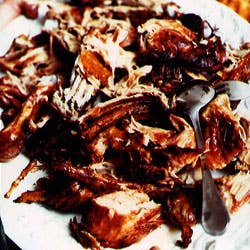
Suckling lamb, abbacchio in Italian, has been the object of what might be called a Roman culinary cult for millennia. Even Juvenal sang the praises of "the tenderest of the flock, with more milk than blood, that has not lost its virginity by eating grass." Ideally, the abbachio should be between 30 and 60 days old, and have lost most of its baby fat without becoming tough. There is no set weight for abbachio; it depends on the breed, and can range from about 12 pounds to 16 or 17. All breeds of lamb are good, but for Easter, some prefer the abbacchio romanesco, raised on ancient pastureland near Rome.
Abbacchio used to be strictly a springtime treat, but with an international supply now available, it can be had year-round. Nevertheless, for many Romans, abbacchio is an Easter dish.
The term derives from the verb abbacchiare , to beat down or demoralize—in turn derived from bacchiare , to beat fruit from trees with a bacchio , or long stick. It is possible that suckling lambs were once clubbed to death with a similar implement. But a kinder etymology is possible: Abbacchiare also means to sell at bargain-basement prices—to dump on the market. Baby lambs are abundant in spring, which drove down prices. As Roman restaurateur Ninetta Ceccacci Mariani explains, "Baby lambs used to come pouring onto the market all at once, because lamb was raised seasonally. The land can support only so many sheep, so eating the lambs around Eastertime made sense, because they were available and affordable. But butchers were clever in their marketing, and used religious festivities to hike up the prices."
Keep Reading
Continue to Next Story










